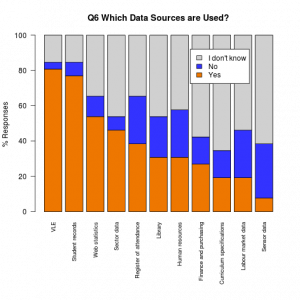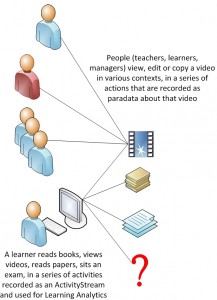Link: CETIS Analytics Series Vol 1. No 4. Analytics for Understanding Research (pdf)
Link: CETIS Analytics Series Vol 1. No 4. Analytics for Understanding Research (MS Word .docx)
Analytics seeks to expose meaningful patterns in data. In this paper, we are concerned with analytics as applied to the process and outputs of research. The general aim is to help optimise research processes and deliver improved research results.
Analytics is the use of mathematical and algorithmic methods to describe part of the real world, reducing real-world complexity to a more easily understandable form. The users of analytics seek to use the outputs of analytics to better understand that part of the world; often to inform planning and decision-making processes. Applied to research, the aim of analytics is to aid in understanding research in order to better undertake processes of planning, development, support, enactment, assessment and management of research.
Analytics has had a relatively a long history in relation to research: the landmark development of citation-based analytics was approximately fifty years ago. Since then the field has developed considerably, both as a result of the development of new forms of analytics, and, recently, in response to new opportunities for analytics offered by the Web.
Exciting new forms of analytics are in development. These include methods to visualise research for comparison and planning purposes, new methods – altmetrics – that exploit information about the dissemination of research that may be extracted from the Web, and social network and semantic analysis. These methods offer to markedly broaden the application areas of analytics.
The view here is that the use of analytics to understand research is a given part of contemporaneous research, at researcher, research group, institution, national and international levels. Given the fundamental importance of assessment of research and the role that analytics may play, it is of paramount importance for the future of research to construct institutional and national assessment frameworks that use analytics appropriately.
Evidence-based impact agendas are increasingly permeating research, and adding extra impetus to the development and adoption of analytics. Analytics that are used for the assessment of impact are of concern to individual researchers, research groups, universities (and other institutions), cross-institutional groups, funding bodies and governments. UK universities are likely to increase their adoption of Current Research Information Systems (CRIS) that track and summarise data describing research within a university. At the same time, there is also discussion of increased ‘professionalisation’ of research management at an institutional level, which in part refers to increasing standardisation of the profession and its practices across institutions.
The impetus to assess research is, for these and other social, economic and organisational reasons, inevitable. In such a situation, reduction of research to ‘easily understandable’ numbers is attractive, and there is a consequent danger of over-reliance on analytic results without seeing the larger picture.
With an increased impetus to assess research, it seems likely that individual researchers, research groups, departments and universities will start to adopt practices of research reputation management. However, the use of analytics to understand research is an area fraught with difficulties that include questions about the adequacy of proxies, validity of statistical methods, understanding of indicators and metrics obtained by analytics, and the practical use of those indicators and metrics in helping to develop, support, assess and manage research.
To use analytics effectively, one must at least understand some of these aspects of analytics, and certainly understand the limitations of different analytic approaches. Researchers, research managers and senior staff might benefit from analytics awareness and training events.
Various opportunities and attendant risks are discussed in section 5. The busy reader might care to read that section before (or instead of) any others.
Continue reading →


